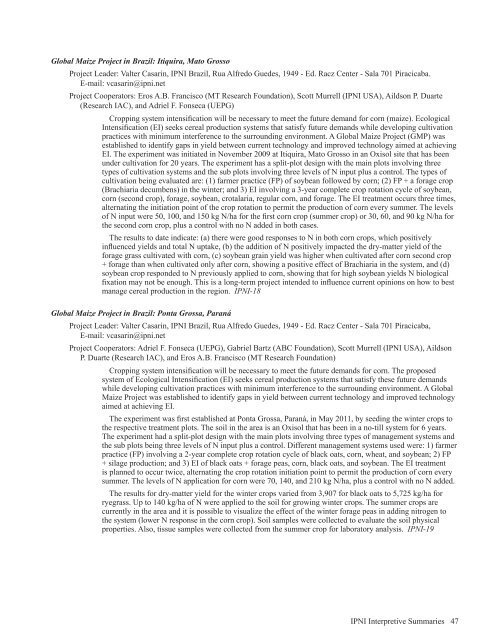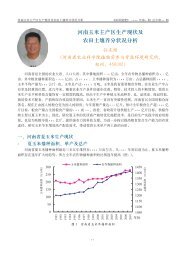Americas and Oceania Group - International Plant Nutrition Institute
Americas and Oceania Group - International Plant Nutrition Institute
Americas and Oceania Group - International Plant Nutrition Institute
You also want an ePaper? Increase the reach of your titles
YUMPU automatically turns print PDFs into web optimized ePapers that Google loves.
Global Maize Project in Brazil: Itiquira, Mato Grosso<br />
Project Leader: Valter Casarin, IPNI Brazil, Rua Alfredo Guedes, 1949 - Ed. Racz Center - Sala 701 Piracicaba.<br />
E-mail: vcasarin@ipni.net<br />
Project Cooperators: Eros A.B. Francisco (MT Research Foundation), Scott Murrell (IPNI USA), Aildson P. Duarte<br />
(Research IAC), <strong>and</strong> Adriel F. Fonseca (UEPG)<br />
Cropping system intensification will be necessary to meet the future dem<strong>and</strong> for corn (maize). Ecological<br />
Intensification (EI) seeks cereal production systems that satisfy future dem<strong>and</strong>s while developing cultivation<br />
practices with minimum interference to the surrounding environment. A Global Maize Project (GMP) was<br />
established to identify gaps in yield between current technology <strong>and</strong> improved technology aimed at achieving<br />
EI. The experiment was initiated in November 2009 at Itiquira, Mato Grosso in an Oxisol site that has been<br />
under cultivation for 20 years. The experiment has a split-plot design with the main plots involving three<br />
types of cultivation systems <strong>and</strong> the sub plots involving three levels of N input plus a control. The types of<br />
cultivation being evaluated are: (1) farmer practice (FP) of soybean followed by corn; (2) FP + a forage crop<br />
(Brachiaria decumbens) in the winter; <strong>and</strong> 3) EI involving a 3-year complete crop rotation cycle of soybean,<br />
corn (second crop), forage, soybean, crotalaria, regular corn, <strong>and</strong> forage. The EI treatment occurs three times,<br />
alternating the initiation point of the crop rotation to permit the production of corn every summer. The levels<br />
of N input were 50, 100, <strong>and</strong> 150 kg N/ha for the first corn crop (summer crop) or 30, 60, <strong>and</strong> 90 kg N/ha for<br />
the second corn crop, plus a control with no N added in both cases.<br />
The results to date indicate: (a) there were good responses to N in both corn crops, which positively<br />
influenced yields <strong>and</strong> total N uptake, (b) the addition of N positively impacted the dry-matter yield of the<br />
forage grass cultivated with corn, (c) soybean grain yield was higher when cultivated after corn second crop<br />
+ forage than when cultivated only after corn, showing a positive effect of Brachiaria in the system, <strong>and</strong> (d)<br />
soybean crop responded to N previously applied to corn, showing that for high soybean yields N biological<br />
fixation may not be enough. This is a long-term project intended to influence current opinions on how to best<br />
manage cereal production in the region. IPNI-18<br />
Global Maize Project in Brazil: Ponta Grossa, Paraná<br />
Project Leader: Valter Casarin, IPNI Brazil, Rua Alfredo Guedes, 1949 - Ed. Racz Center - Sala 701 Piracicaba,<br />
E-mail: vcasarin@ipni.net<br />
Project Cooperators: Adriel F. Fonseca (UEPG), Gabriel Bartz (ABC Foundation), Scott Murrell (IPNI USA), Aildson<br />
P. Duarte (Research IAC), <strong>and</strong> Eros A.B. Francisco (MT Research Foundation)<br />
Cropping system intensification will be necessary to meet the future dem<strong>and</strong>s for corn. The proposed<br />
system of Ecological Intensification (EI) seeks cereal production systems that satisfy these future dem<strong>and</strong>s<br />
while developing cultivation practices with minimum interference to the surrounding environment. A Global<br />
Maize Project was established to identify gaps in yield between current technology <strong>and</strong> improved technology<br />
aimed at achieving EI.<br />
The experiment was first established at Ponta Grossa, Paraná, in May 2011, by seeding the winter crops to<br />
the respective treatment plots. The soil in the area is an Oxisol that has been in a no-till system for 6 years.<br />
The experiment had a split-plot design with the main plots involving three types of management systems <strong>and</strong><br />
the sub plots being three levels of N input plus a control. Different management systems used were: 1) farmer<br />
practice (FP) involving a 2-year complete crop rotation cycle of black oats, corn, wheat, <strong>and</strong> soybean; 2) FP<br />
+ silage production; <strong>and</strong> 3) EI of black oats + forage peas, corn, black oats, <strong>and</strong> soybean. The EI treatment<br />
is planned to occur twice, alternating the crop rotation initiation point to permit the production of corn every<br />
summer. The levels of N application for corn were 70, 140, <strong>and</strong> 210 kg N/ha, plus a control with no N added.<br />
The results for dry-matter yield for the winter crops varied from 3,907 for black oats to 5,725 kg/ha for<br />
ryegrass. Up to 140 kg/ha of N were applied to the soil for growing winter crops. The summer crops are<br />
currently in the area <strong>and</strong> it is possible to visualize the effect of the winter forage peas in adding nitrogen to<br />
the system (lower N response in the corn crop). Soil samples were collected to evaluate the soil physical<br />
properties. Also, tissue samples were collected from the summer crop for laboratory analysis. IPNI-19<br />
IPNI Interpretive Summaries 47

















